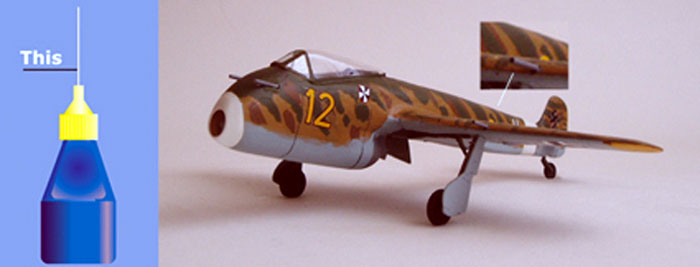|
Tech Tips
Part One

by Peter Allen

HyperScale is proudly supported by Squadron
I have recently given some thought about new modelers in general and
young newcomers in particular. With this in mind I have put together a few
simple tech tips guides.
Tech tips have certainly helped me achieve a higher standard than I
would have without them. I hope that you will find these tips useful:
Tip 1: Gun Barrels
If you don't have a supply of hypodermic needles to make gun barrels
from, simply save the application tubes from Humbrol or Revell precision
cement applicator bottles and cut them as required.
As they are tubes that might crush if they are cut with pincers, so it
is best to saw them as on the Unicraft Fw P1 shown in the title image.
Tip 2: Securing Ballast Weights
I have dispensed with super-glue for securing nose/ballast weights as
it tends to be brittle once dry and, of course, it can be very messy. (We
all know super-glue seems to like human fingers more than any other
substance known to man).
I found by accident that blu-tac or similar is perfect. It holds the
weights in place without any problems.

Every model in which I have used blu-tac has never lost a weight even
after 2 years, unlike those using super-glue.
No more rogue weights rattling around the fuselage interior!
 Tip
3: Where to Place Ballast Weights Tip
3: Where to Place Ballast Weights
If there is not enough room in the extreme tip of the nose to
accommodate weight, any space ahead of the main undercarriage is fair
game, bearing in mind that the further forward the weight is the less is
needed.
Amongst possible areas for adding weight are:
-
Immediately behind the cockpit in forward
cockpit aircraft.
-
On twin or multiple engine aircraft, in the
engine nacelles.
-
In the leading edges of main wings.
-
In any belly mounted bombs or wing mounted
fuel tanks that are big and/or hollow enough to take weight and are far
enough forward.
For some resin models the rear fuselage may need to be drilled out to
make it as light as possible and therefore easier to counterbalance
forward placed weight.
HAVE FUN
Peter |
Home |
What's New |
Features |
Gallery |
Reviews |
Reference |
Forum |
Search